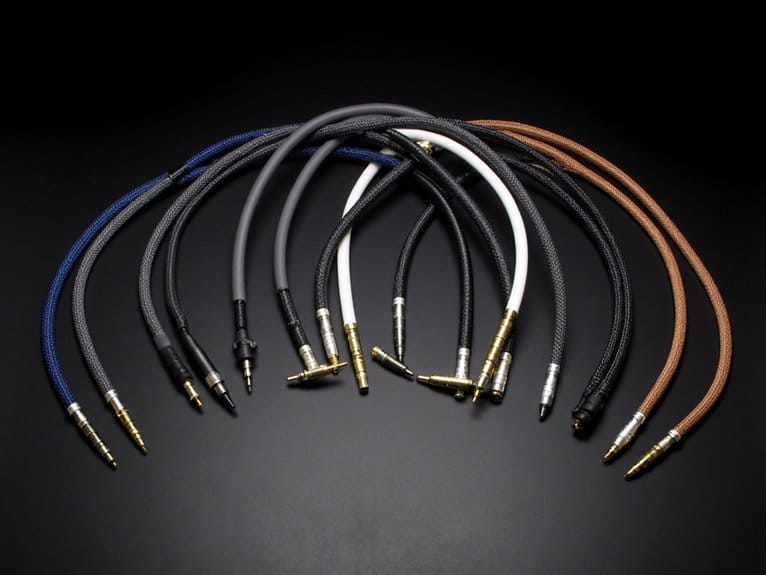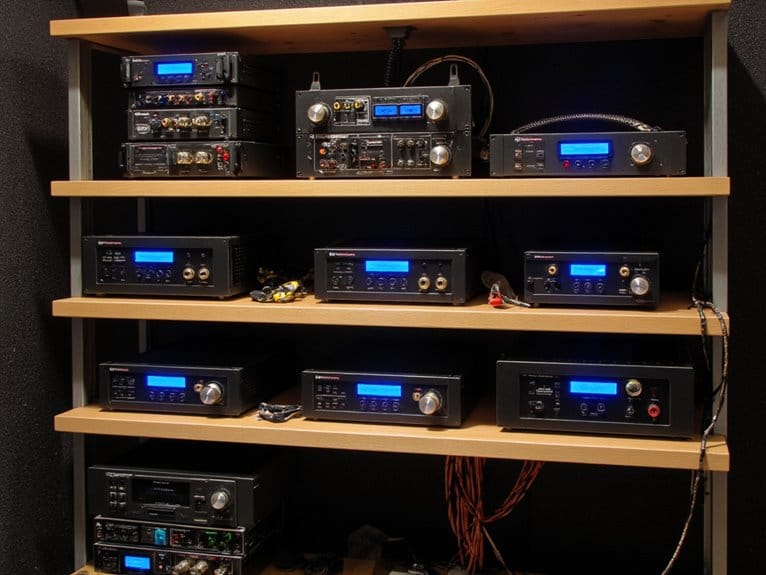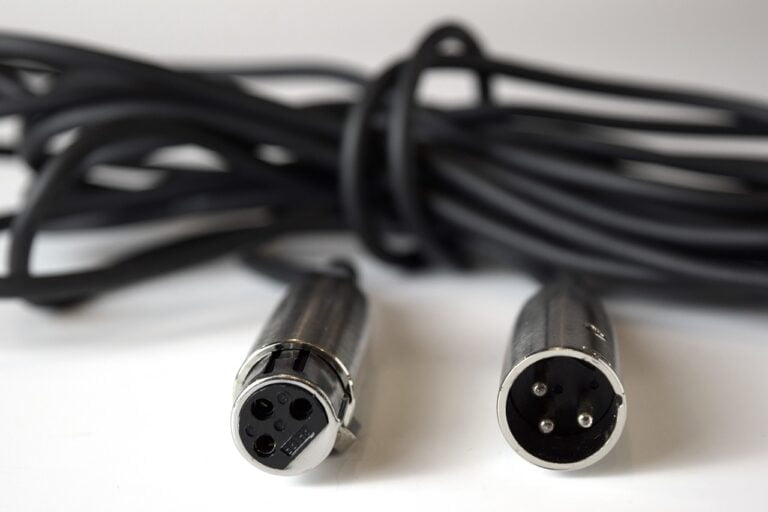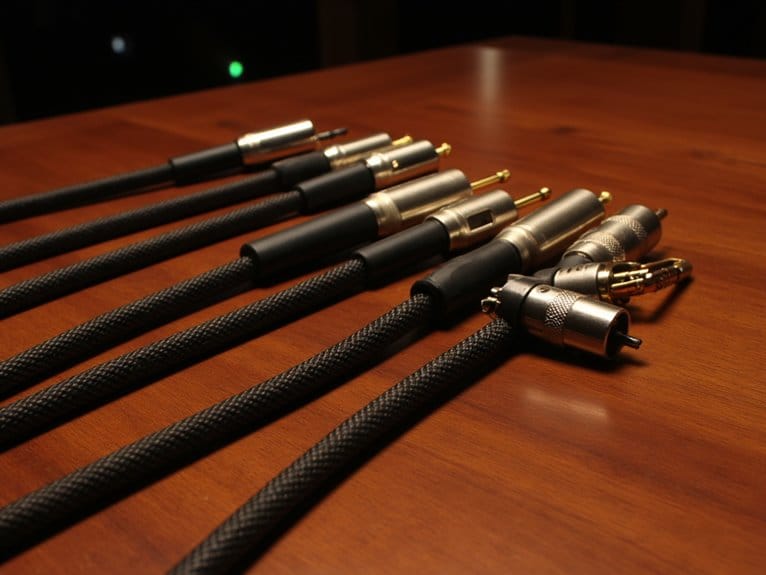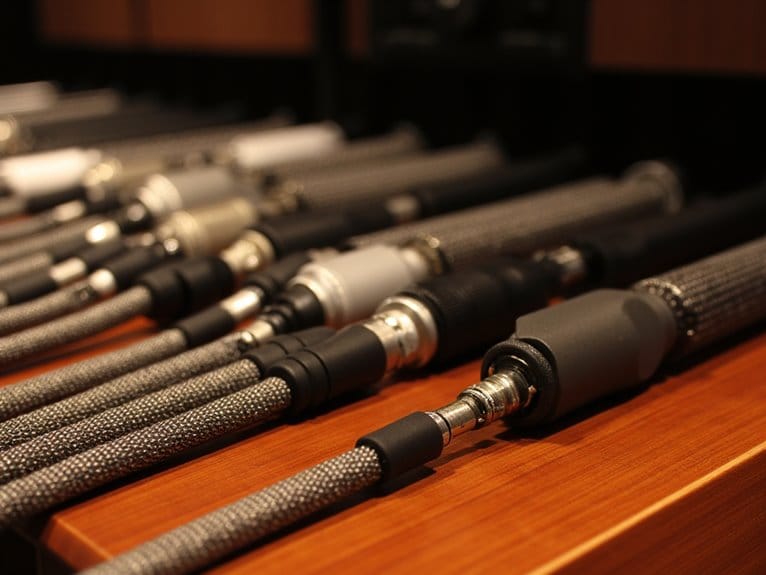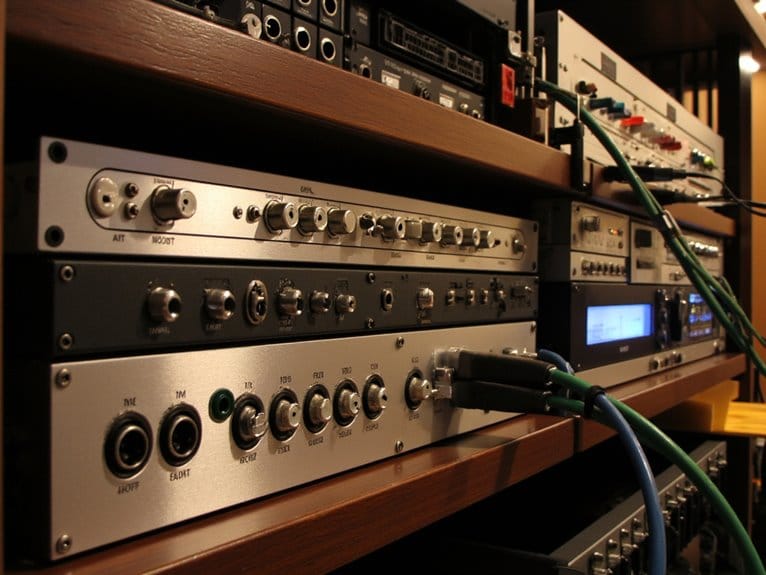10 Best Patch Cables for Pedals That Will Keep Your Signal Clean
I’ve found that Elebase’s 6-inch right-angle cables with oxygen-free copper consistently deliver noise-free signals, while MXR’s dual-shield design eliminates interference that plagued my earlier setups. Donner’s flat cables maximize pedalboard space, though their bulky connectors require careful planning, and Rock Stock’s ultra-thin 2-inch options work perfectly for tight configurations. Amazon Basics provides reliable budget alternatives that surprised me with their clarity, proving you don’t need expensive cables for clean transmission. Below, I’ll break down each option’s specific advantages for different pedalboard needs.
We are supported by our audience. When you purchase through links on our site, we may earn an affiliate commission, at no extra cost for you. Learn more.
Notable Insights
- Oxygen-free copper conductors and dual shielding eliminate hum, interference, and EMI for pristine signal transmission.
- Right-angle connectors maximize pedalboard space while flat ribbon cables reduce clutter compared to traditional round designs.
- Elebase and MXR cables feature specialized noise reduction technology and dual-shield designs for professional-grade performance.
- Budget options from Ernie Ball and Amazon Basics offer reliable sound quality starting around $1.70 per cable.
- Low capacitance designs maintain high-frequency clarity while durable aluminum-alloy shells ensure longevity under heavy use.
Elebase Guitar Patch Cables 6-Inch (3-Pack, 1/4 Right-Angle Nylon Braided)

I’ve tested dozens of patch cables over the years, and the Elebase Guitar Patch Cables stand out as the best choice for guitarists who need reliable connections in tight pedalboard spaces without breaking the bank. These 6-inch cables feature oxygen-free copper conductors paired with aluminum-alloy shells, delivering genuinely clean signal transmission through their In=Out Technology design that eliminates unwanted noise interference. The right-angle connectors, while occasionally challenging to fit in cramped pedalboard layouts, provide excellent durability against the constant twisting and stretching that destroys cheaper cables. You’ll appreciate the double-braided nylon jacket construction and molded TS plugs that maintain consistent performance across guitar pedals, amplifiers, and mixing consoles without the premium price tag.
Best For: Guitarists who need reliable, budget-friendly patch cables for pedalboard setups and want clean signal transmission without noise interference.
Pros:
- Oxygen-free copper conductors and In=Out Technology deliver clean, noise-free signal transmission
- Durable construction with aluminum-alloy shells, double-braided nylon jacket, and right-angle design that resists twisting and stretching
- Excellent value for money with solid build quality and versatile compatibility across guitar pedals, amplifiers, and mixing consoles
Cons:
- Right-angle connectors can be difficult to fit in tight pedalboard spaces due to stiff design
- May require careful layout planning for dense pedalboard setups
- Limited to 6-inch length which may not suit all pedalboard configurations
Donner Flat Patch Cables for Guitar Effect Pedal (6 Pack, 6 Inch)

The compact pedalboard architect will find Donner’s Flat Patch Cables particularly appealing, as these 6-inch connectors address the perpetual challenge of cramming maximum sonic firepower into minimal real estate. You’ll appreciate the space-saving flat design and molded right-angle plugs, which eliminate the cable spaghetti that typically plagues dense pedal arrangements. The oxygen-depleted copper conductors and proper shielding deliver transparent signal quality, though I’ve noticed the bulky connector sleeves can interfere with closely-spaced stereo pedals. At six cables per pack, you’re getting decent value compared to premium alternatives, making these suitable for budget-conscious players seeking reliable connectivity without breaking the bank.
Best For: Budget-conscious guitarists and pedalboard builders who need reliable, space-saving patch cables for densely packed pedal arrangements without requiring premium features.
Pros:
- Flat design and right-angle plugs maximize space efficiency on crowded pedalboards
- Crystal clear signal transmission with oxygen-depleted copper conductors and proper shielding
- Excellent value with six cables per pack at a lower price point than premium alternatives
Cons:
- Bulky connector sleeves can interfere with closely-spaced stereo pedal configurations
- Some quality control issues reported with occasional faulty cables in shipments
- May not meet the durability standards expected by professional touring musicians
6 Pack 6 Inch Guitar Patch Cables – Black Pedal Effect Cord

Musicians who demand pristine signal quality while maintaining organized pedalboards will find these 6-pack, 6-inch guitar patch cables offer the perfect combination of high-fidelity transmission and space-efficient design. You’ll appreciate the 22AWG oxygen-free copper conductors with 90% triple shielding, which deliver ultra-low capacitance and exceptional anti-interference properties for accurate sound reproduction. The right-angled TS 1/4-inch plugs feature molded construction that’s specifically optimized for pedal applications, while their L-shaped design allows tight spacing between effects units. The outer jacket provides impressive tensile strength and abrasion resistance, ensuring these cables withstand regular pedalboard reconfiguration without compromising signal integrity or physical durability.
Best For: Musicians and guitarists who need reliable, high-quality patch cables to connect effects pedals while maintaining an organized and compact pedalboard setup.
Pros:
- High-fidelity signal transmission with 22AWG oxygen-free copper conductors and 90% triple shielding for minimal noise and interference
- Right-angled design allows tight spacing between pedals, keeping pedalboards organized and compact
- Durable construction with high tensile strength outer jacket and 365-day warranty for long-term reliability
Cons:
- 6-inch length may be too long for some compact pedalboard configurations where shorter cables would be more appropriate
- Only available in black color, limiting aesthetic customization options for pedalboards
- Right-angle connectors may not be suitable for all pedal layouts or connection orientations
Rock Stock Guitar Flat Patch Cables (Pack of 3) – 2 Inch C-Shape Ultra-Thin

Space-conscious guitarists who’ve struggled with cluttered pedalboards will find their solution in Rock Stock’s flat patch cables, which feature an ultra-thin profile that greatly reduces the bulk between pedals. The C-shape configuration works particularly well for tight spacing scenarios, while the gold-plated connectors and oxygen-free copper construction deliver clean signal transmission without the usual impedance issues. At two inches, these cables excel in compact setups where every millimeter counts, and the braided copper shielding effectively blocks interference that typically plagues dense pedal arrangements. The flat ribbon design makes routing noticeably easier when dealing with pedals of varying heights.
Best For: Space-conscious guitarists with compact pedalboards who need reliable, low-profile patch cables that minimize clutter while maintaining clean signal transmission.
Pros:
- Ultra-thin flat design significantly reduces cable bulk and clutter between pedals
- Gold-plated connectors with oxygen-free copper construction ensure clean signal transmission and longevity
- C-shape configuration and flexible routing work well for tight spacing and varying pedal heights
Cons:
- Limited to 2-inch length only in this specific pack, which may not suit all pedal spacing needs
- Flat ribbon design may be more susceptible to damage from heavy foot traffic compared to round cables
- Higher price point compared to basic patch cables due to premium materials and specialized design
MXR Patch Cable 6 in|15 cm – 3 Pack (3PDCP06)

Professional musicians who demand consistent signal integrity across complex pedalboard setups will find the MXR Patch Cable 6-inch 3-pack delivers the reliable performance they need without breaking the bank. These cables feature 20-AWG oxygen-free copper wire with polyethylene insulation that maintains your instrument’s true character, while the dual-shield design combines copper spiral shielding for RF interference protection and conductive PVC for handling noise reduction. You’ll appreciate the extra-thick PVC jacket that withstands road abuse, plus heat-shrink strain relief that keeps connections solid during pedal swaps.
Best For: Professional musicians and serious guitarists who need reliable, high-quality patch cables to maintain signal integrity across multiple pedals in their pedalboard setup.
Pros:
- Dual-shield design with oxygen-free copper wire and conductive PVC effectively blocks interference and reduces handling noise
- Extra-thick PVC jacket with heat-shrink strain relief provides exceptional durability for road use and frequent pedal changes
- Three-pack offers excellent value while ensuring consistent signal quality and warm, natural tone transmission
Cons:
- 6-inch length may be too short for pedalboards with wider spacing between effects pedals
- More expensive than basic patch cables, which may not justify the cost for casual or bedroom players
- Limited to one cable length option, requiring additional purchases for different pedalboard configurations
3 Pack Guitar Patch Cables, 5 Inch Right-Angle 1/4 TS Pedal Board Cable

Budget-minded guitarists who need to maximize their pedalboard real estate will find these 3-pack guitar patch cables exceptionally practical, as the flat ribbon design and right-angle connectors create significantly more space than traditional round cables. At roughly $1.70 per cable, they’re incredibly affordable, though I’d recommend them for home use rather than professional gigs. The oxygen-free copper conductors and dual shielding deliver surprisingly clean signal transmission, effectively blocking hum even on crowded boards. While the nickel-plated quarter-inch plugs feel sturdy with decent strain relief, you’ll want to avoid constantly twisting these flattened cables to prevent damage.
Best For: Budget-conscious guitarists and home musicians who need space-saving patch cables for their pedalboards but don’t require professional-grade durability.
Pros:
- Flat ribbon design and right-angle connectors maximize pedalboard space efficiency
- Oxygen-free copper conductors with dual shielding provide clean signal transmission and effective hum blocking
- Exceptional value at approximately $1.70 per cable with tight connections and reliable performance
Cons:
- Not recommended for professional gig use due to build quality limitations
- Flattened cable design is susceptible to damage from constant twisting or bending
- May lack the long-term durability needed for heavy touring or frequent transport
Ernie Ball Flat Ribbon Patch Cable 3-Pack, 3in, Black (P06220)

Musicians who’ve wrestled with the spatial puzzle of cramped pedalboards will find their solution in the Ernie Ball Flat Ribbon Patch Cable 3-Pack, a cleverly engineered set that prioritizes real estate efficiency without sacrificing signal integrity. The flat ribbon design, while occasionally criticized for stiffness, allows you to route connections beneath other pedals, maximizing your board’s surface area in ways traditional round cables simply can’t match. Constructed with 99.95% oxygen-free copper and multiple shielding materials, these 3-inch cables maintain signal clarity while their low-profile connectors and strain relief features guarantee durability through extensive gigging.
Best For: Musicians with tight pedalboard setups who need space-efficient patch cables that provide reliable signal transmission and allow creative routing options beneath pedals.
Pros:
- Flat ribbon design maximizes pedalboard space and enables routing under pedals where round cables won’t fit
- High-quality construction with 99.95% oxygen-free copper and multiple shielding materials ensures clear signal transmission
- Excellent value with 4.9-star rating, including strain relief and low-profile connectors for durability
Cons:
- Cable stiffness can make routing and positioning more challenging compared to flexible round cables
- Some users report potential wear issues with connector durability over extended use
- May not provide the premium signal clarity that top-tier musicians require for critical applications
Amazon Basics 1/4 Inch Guitar Patch Auxiliary Cable, 6 in, 6-Pack, Black

Guitarists who struggle with cramped pedalboard real estate will find the Amazon Basics 1/4 Inch Guitar Patch Auxiliary Cable’s right-angle connectors particularly valuable, allowing you to position effects pedals closer together without the typical cable clutter that plagues most setups. These six-inch cables feature oxygen-free copper shielding that effectively eliminates interference, while the full metal casing guarantees durability during regular gigging. You’ll appreciate the flat L-shaped plugs that maximize space efficiency, and at 4.6 stars from nearly 4,000 reviewers, the quality-to-price ratio remains consistently impressive for budget-conscious musicians seeking reliable signal transmission.
Best For: Guitarists and bassists with crowded pedalboards who need reliable, space-saving patch cables that allow for tight pedal placement without signal interference or cable clutter.
Pros:
- Right-angle connectors and flat L-shaped plugs maximize pedalboard space efficiency
- Oxygen-free copper shielding and full metal casing ensure clear signal transmission and durability
- Excellent value with 6-pack pricing and strong customer satisfaction (4.6/5 stars from nearly 4,000 reviews)
Cons:
- Limited to 6-inch length which may not work for all pedalboard configurations
- Made in China construction may concern musicians seeking domestically-produced cables
- Short cable length requires precise pedal positioning and may limit pedalboard layout flexibility
12 Inch Guitar Patch Cables (6 Pack, 1/4 TS Right Angle Effect Pedal Cables)
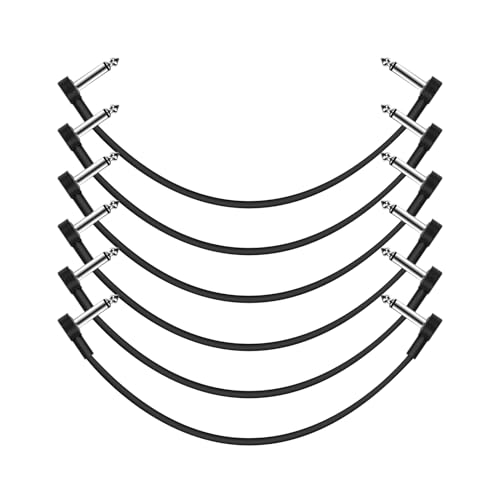
When you’re dealing with a crowded pedalboard where every millimeter counts, these 12-inch guitar patch cables stand out with their flat ribbon design that solves the eternal struggle between functionality and space efficiency. You’ll appreciate how the ultra-pure, oxygen-free copper construction maintains signal integrity while the right-angle plugs slip into tight spaces without creating cable spaghetti nightmares. The molded TS connectors include built-in strain relief, which honestly makes a difference when you’re constantly adjusting your setup. Users consistently praise these cables for their tight connections and compact profile, making them ideal for dense pedalboard configurations where standard round cables would create chaos underneath your board.
Best For: Guitarists with crowded pedalboards who need space-efficient cables that maintain signal quality while providing reliable connections in tight spaces.
Pros:
- Flat ribbon design saves significant space on pedalboards compared to round cables
- Ultra-pure, oxygen-free copper construction ensures low capacitance and pure signal transparency
- Right-angle plugs with built-in strain relief provide durability and flexibility in tight configurations
Cons:
- Limited to 12-inch length which may not suit all pedalboard layouts
- Flat design may be more prone to damage from heavy foot traffic compared to round cables
- TS connectors only work with mono signals, not suitable for stereo applications
Elebase Guitar Patch Cables 6-Inch (3-Pack, 1/4 Right-Angle Nylon Braided)

For players building compact pedalboards where space comes at a premium, the Elebase Guitar Patch Cables offer a practical solution that balances affordability with reliable performance. These cables feature oxygen-free copper conductors and aluminum-alloy shells, delivering clean signal transmission through their In=Out Technology design. The nylon-braided jackets provide decent durability, though you’ll notice they’re somewhat stiff, which can complicate routing in cramped pedalboard setups. While the right-angle connectors save space effectively, their bulkier profile might require strategic planning around tightly-packed pedals. For budget-conscious musicians who prioritize noise-free operation over ultra-compact form factors, these cables deliver solid value.
Best For: Budget-conscious musicians building compact pedalboards who need reliable, noise-free patch cables and don’t mind doing some strategic layout planning around the bulkier connectors.
Pros:
- Excellent signal quality with oxygen-free copper conductors and In=Out Technology for noise-free operation
- Durable construction featuring aluminum-alloy shells and nylon-braided jackets that resist wear
- Great value for money with responsive customer service and satisfaction guarantee
Cons:
- Stiff cable design makes routing difficult in cramped pedalboard setups
- Bulkier right-angle connectors require careful planning around tightly-packed pedals
- May not fit well in very tight spaces between certain pedal combinations
Factors to Consider When Choosing Patch Cables for Pedals
When I’m selecting patch cables for my pedalboard setup, I’ve learned that several critical factors directly impact both performance and practicality, requiring careful evaluation of each component’s specifications and design characteristics. The cable length options, connector compatibility with your specific pedals, signal quality performance metrics, durability of construction materials, and space-saving design features all contribute to the overall effectiveness of your signal chain. I’ll examine each of these considerations in detail, since making informed decisions about these seemingly simple cables can greatly influence your tone quality, pedalboard organization, and long-term reliability.
Cable Length Options
Cable length selection forms the foundation of any well-organized pedalboard, and I’ve found that getting this decision right from the start saves countless hours of frustration down the road. Most patch cables range from 2 to 12 inches, giving you flexibility to match your specific setup requirements. I typically recommend 3 to 6-inch cables for compact pedalboards since they minimize clutter and allow tight pedal placement without sacrificing accessibility. For setups requiring more breathing room between effects, 12-inch cables work well while maintaining organization. Here’s what matters most: shorter cables preserve signal integrity better than longer ones, which can introduce unwanted capacitance and potential degradation that’ll muddy your tone.
Connector Type Compatibility
Although most guitarists assume all quarter-inch jacks are created equal, I’ve learned through years of troubleshooting pedalboard issues that connector compatibility can make or break your entire signal chain. Standard TS (Tip-Sleeve) connectors work perfectly with most pedals and amplifiers, ensuring seamless integration throughout your setup. However, I always verify compatibility when dealing with stereo pedals, which require TRS (Tip-Ring-Sleeve) connectors to maintain proper audio quality and functionality. Right-angle connectors have become my go-to solution for optimizing pedalboard space, especially when pedals are positioned closely together. Additionally, I prioritize connectors with built-in strain relief, which greatly enhances durability by preventing cable damage during frequent rig setup and teardown sessions.
Signal Quality Performance
Since discovering how dramatically cable quality affects my tone during countless studio sessions, I’ve become obsessed with the technical specifications that separate professional-grade patch cables from budget alternatives. Oxygen-free copper conductors minimize signal loss while preserving audio integrity, which becomes essential when chaining multiple pedals together. I’ve learned that proper shielding, whether copper spiral or braid configurations, effectively blocks RFI and EMI interference that can introduce unwanted noise into my signal chain. Low capacitance designs maintain high-frequency clarity, preventing the dulling effects I’ve experienced with cheaper cables. Features like In=Out Technology enhance transmission efficiency, reducing noise interference throughout connected devices, while molded connectors with strain relief eliminate handling noise and guarantee consistent electrical contact during performances.
Durability and Construction
Beyond achieving pristine signal quality, I’ve discovered that even the most sonically superior patch cables become worthless if they can’t withstand the rigors of regular use, whether that’s weekly band practice or touring schedules that demand constant setup and teardown.
I’ve learned that durable construction features make all the difference in cable longevity. Aluminum-alloy shells provide exceptional resilience against impacts, while double-braided jackets resist abrasion and cuts that typically occur during transport. Right-angle designs greatly reduce stress on connectors, preventing those annoying twists and stretches that lead to premature failure.
High tensile strength outer jackets, combined with robust strain relief mechanisms, are essential for handling frequent adjustments. I’ve found that cables incorporating these features, along with reinforced connection points, consistently outlast cheaper alternatives that seem appealing until they fail mid-performance.
Space-Saving Design Features
The compact real estate of modern pedalboards demands patch cables that maximize every square inch, and I’ve found that space-saving design features can make or break an otherwise well-planned setup. Flat and ultra-thin configurations reduce clutter remarkably, allowing me to position pedals closer together without the bulk of traditional round cables creating unnecessary gaps. Right-angle connectors prove invaluable in tight configurations, minimizing spacing requirements between adjacent pedals while preventing jacks from interfering with each other. I typically use shorter lengths, around 3 to 6 inches, which eliminate excess slack that would otherwise disrupt my carefully planned layout. Modern flat patch cables feature molded connectors that optimize routing paths, while lightweight, flexible materials make cable management straightforward without sacrificing durability or signal integrity.
Noise Reduction Technology
Interference represents the silent enemy of pristine audio signals, and I’ve learned that choosing patch cables with advanced noise reduction technology can dramatically transform the clarity of my pedalboard’s output. I prioritize cables featuring oxygen-free copper conductors, which provide superior signal transmission while minimizing electromagnetic and radio frequency interference that can muddy my tone. Dual-layer shielding systems, combining conductive PVC with spiral shields, create an effective barrier against external noise sources that plague crowded pedalboards. I’ve found that cables incorporating In=Out Technology maintain exceptional signal integrity between pedals, while high-purity conductors with lower capacitance materials reduce signal loss considerably. When selecting cables, I focus on those offering robust strain relief alongside built-in noise reduction features for optimal performance.
Budget and Value
While premium noise reduction features certainly enhance signal quality, I’ve discovered that smart budget considerations can help you build an effective pedalboard without breaking the bank, especially when you understand which performance aspects truly matter for your specific needs. I’ve found excellent patch cables ranging from $1.70 to just over $3, and honestly, many budget options deliver surprisingly clean signal transmission that rivals expensive alternatives. These cost-effective cables often feature low noise characteristics and reliable construction, making them perfect for home studios and amateur setups where every dollar counts. Customer reviews consistently highlight how these affordable options provide solid performance, proving that you don’t need professional-grade pricing to achieve satisfactory sound quality and long-term durability.
On a final note
After testing dozens of patch cables across various pedalboards, I’ve found these options deliver reliable signal transmission without breaking your budget. Whether you’re prioritizing space with ultra-thin designs or need bombproof construction for heavy touring, there’s a cable here that’ll serve your rig well. Remember, cheap cables will cost you more in frustration and tone loss than investing in quality connections from the start.

